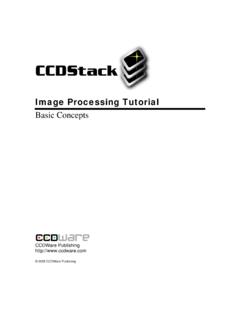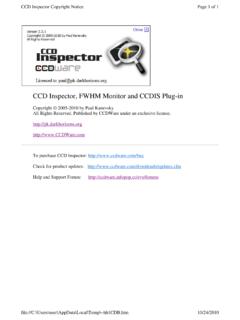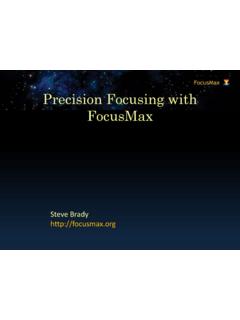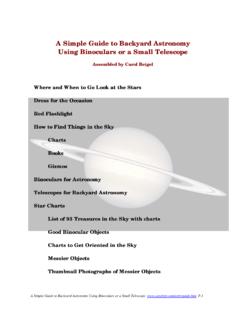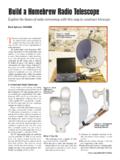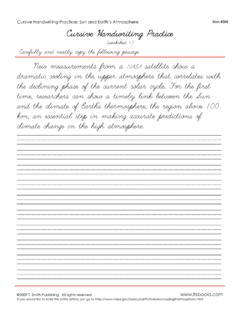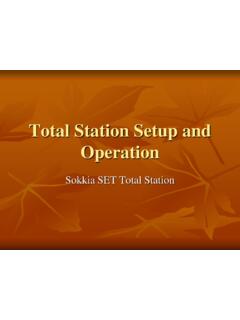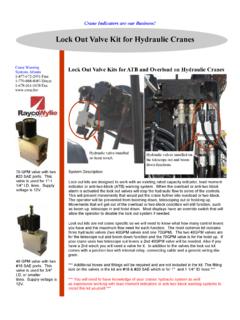Transcription of Fast Auto-Focus Method and Software for CCD-based …
1 Fast Auto-Focus Method and Software for CCD-based Telescopes [1]. By Larry Weber and Steve Brady Introduction Focusing CCD-based telescopes is one of the drudgeries astronomers constantly face. With the recent advent of relatively low cost, motorized position-feedback focusing hardware, comes an opportunity to fully automate the focusing operation. This paper presents a new Method and Software for automatically focusing CCD based telescope systems. It is highly suitable for unattended all-night robotic- telescope operations such as asteroid searches, astrometry, photometry, imaging, etc. The only requirements are a CCD based telescope , a commercially available position-feedback motorized-focuser [2] and CCD camera control Software [3].
2 Automated focusing systems demand solution to a wide range of challenging technical problems and specifications. Ideally, any automated focus Method should: Have accuracy equal to or better than the manual mode of focusing that it replaces Be fast so that valuable observing time is not lost Be robust so that the user can expect it to arrive at the correct focus even in marginal conditions such as thin clouds or strong sky glow Be capable of accommodating a wide range of initial out of focus star diameters (important with filters of differing optical thickness in a filter wheel). To facilitate full automation, the Software should have a standard ASCOM interface [4] that allows the user to write simple scripts that can coordinate the focusing operation with the other telescope operations.
3 Ideally this means that once the system and Software are properly configured, then the user only needs to press one focus button to initiate a successful focus operation. We believe our Method and Software meets all of these requirements. Degree of focus Metric To meet the above requirements an accurate and robust focus metric is needed. Traditionally, astronomers have used a number of techniques to characterize the Point Spread Function (PSF). of a star. One common Method is a gaussian function fit to the PSF. Unfortunately, severely out of focus stars frequently have the shape of an annulus or disk, which does not match the shape of the gaussian accurately. We have found the Full Width Half Maximum (FWHM) metric used to quantify the width of the star PSF to work most of the time but not with sufficient accuracy for auto -focusing.
4 This is due to variations in seeing which cause local peaks in the unfocused star PSF and severely degrades the calculation of the maximum when assessing the FWHM. We have based our Auto-Focus algorithm on a metric named the Half Flux Diameter (HFD). The HFD is defined as the diameter of a circle that is centered on the unfocused star image in which half of the total star flux is inside the circle and half is outside. The HFD gives a single number, in units of CCD pixels, that is relatively insensitive to variations in seeing, star flux, thin clouds or sky background glow. We have found this one metric to be accurate over a very wide range of unfocused star diameters and flux intensities because the HFD is determined by integrating all of the flux from the unfocused star area.
5 HFD does not suffer from the problems found with gaussian fits or FWHM. Note that in our earlier version of this paper, [1] we defined our degree of focus metric as a Half Flux Radius (HFR). The HFD metric has exactly the same concept as the HFR metric with the obvious identity: HFD = 2 * HFR. We have adopted HFD, at the recommendation of Douglas B. George. This is for user convenience since, for small star disks, the measured HFD value is quite similar to the more familiar FWHM of the star. V Curve Plot A Plot of the measured HFD vs. the precision focus position gives a very stable V shaped curve where the Best focus Position is at the apex of the V. The sample to the left shows actual data that was automatically measured on an 8 inch LX-200, ST-8E system during good seeing conditions near sea level.
6 The horizontal axis is the focuser position and the vertical axis is the HFD. This V Curve is an accurate quantitative measure of the telescope optical convergence cone and beam waist. The measured left and right sides of the V Curve are delightfully linear with slopes that depend only on the hardware characteristics such as the optics f- number, the CCD pixel size and the focuser gear ratios. We have found these slopes to be remarkably constant over temperature and time. The Software automatically fits straight lines to the data between the user specified high and low HFD limits. It also measures the straight-line slopes, position intercepts and the position intercept difference (shown in the lower section). The telescope -CCD-focuser system can be completely characterized by measuring the three parameters, the Left Slope, the Right Slope and the Position Intercept Difference.
7 Once the system is characterized with accurate values for these three parameters, the best focus position can be predicted from a well-sampled HFD measurement at a known position and the additional knowledge of which side of Best focus the system is on. Note, the value of the Position at Best focus shown is only of transient interest and is not useful for characterizing the system. HFD Auto-Focus Strategy To begin, the user must characterize the telescope -CCD-focuser system by automatically measuring the V Curve and extracting the three parameters. In principle, the Best focus Position can be determined with a measured target star HFD, the position of the focuser and knowledge of which side of Best focus the focuser is on.
8 In practice more than one HFD measurement is made and the results are averaged to increase the signal to noise ratio making the Best focus determination more accurate. We have written a user-friendly MS Windows application to automatically focus the telescope . In a typical run the telescope can be routinely brought to focus in only one minute with a LX- 200, ST-8E system. The process is: 1. A non-precision move of the focuser is made to a point that is known to be sufficiently far from Best focus (user selected inside or outside of Best focus ). 2. A full frame 3x3 binned image is taken with a minimal exposure time 3. The brightest star is found, the position determined and the HFD measured 4. The target star is sub-framed and a second exposure taken (download time is minimized due to the smaller frame size).
9 5. The focuser position is then precision moved to a user specified Near focus Position which is determined from target star HFD and the V Curve slope constant 6. An average HFD is determined from a small number of rapid sub frame exposures which reduces the influence of random variables such as seeing 7. The Best focus Position is then determined and the stepper motor automatically moves the focuser to this Position This technique allows accurate determination of the best focus position by moving the focuser in one direction which eliminates issues such as backlash and mirror flop, which are found on many telescope focus mechanisms. This strategy determines Best focus based on the HFD of the one brightest star on the CCD.
10 We have found this one star strategy to be valuable since this star can be centered on the CCD chip to reduce the influence of off axis optical aberrations such as field curvature and coma. With robotic telescope operation, it is relatively easy to find a sufficiently bright star for this strategy. We also allow the user to manually select a single target star in a crowded star field. Currently, the gating time factor in the Auto-Focus process is the slow download time of the CCD. and not exposure time. We have found that if a target star is selected in the 1st to 7th magnitude range, exposure times for can be kept very short and still achieve equal or better performance than longer exposures. For the ST-8E camera we typically use the minimum sec and have good results with the faster sec shutter speeds of the Apogee AM16 camera.
